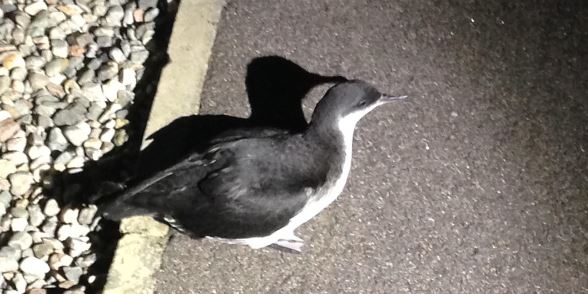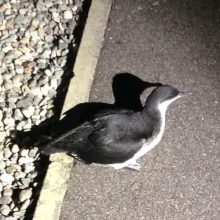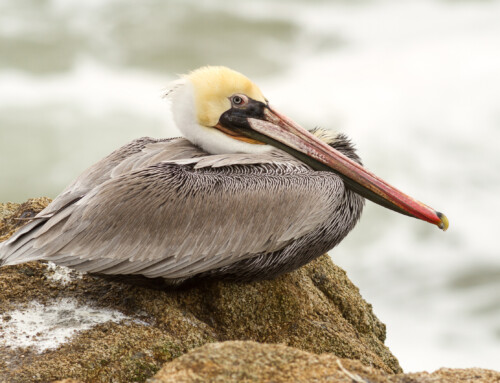How does the combination of light and weather affect Manx shearwaters in Scotland?
LINKED PAPER
Factors influencing Manx Shearwater grounding on the west coast of Scotland. Syposz, M., Gonçalves, F., Carty, M., Hoppitt, W., Manco, F. 2018. IBIS. DOI: 10.1111/ibi.12594. VIEW
Grounding of thousands of newly fledged petrels and shearwaters (family Procellariidae) in built-up areas due to artificial light is a global problem (Rodríguez et al. 2017). Fledglings on their first flight are often found to crash land in the cities and towns near their nest sites. Seabirds that land on the ground are often unable to take off from these urban locations due to their specialised anatomy. Their legs are set far back on the body to facilitate diving, but this ‘forward heavy’ anatomy requires a slope or a gust of wind to allow take-off. Thus, if a grounded bird is not helped, it may fall victim to predation, dehydration, starvation or may be hit by a vehicle (Telfer et al. 1987).

Mallaig is one of the villages where groundings of Manx Shearwaters Puffinus puffinus occur. Mallaig is located on the west coast of the Scottish Highlands 27 km east of the Isle of Rum. The Isle of Rum harbours the second largest nesting site of Manx Shearwaters in the world, with an estimated 76,000 pairs. In September volunteers go around the village in search of grounded Manx Shearwaters. When a bird is found, it is placed in a suitable box, and stored safely until the morning. The following day, rescued birds are ringed and weighed. Manx Shearwaters are then taken on a ferry and released halfway between Mallaig and the Isle of Skye.

We investigated a combination of several factors that may influence the number of groundings in Mallaig. A model was developed that used meteorological variables and moon cycle to predict the daily quantity of birds that were recovered on the ground. The model revealed that during full moon fewer birds ground in the village than during new moon; similar to effects discovered in other studies (Rodríguez & Rodríguez 2009, Miles et al. 2010, Rodríguez et al. 2014). The reason for the moon influence can be explained by the fact that a greater ambient light from the moon may cause a diminution of attraction to the artificial light. In addition it was found that strong onshore winds cause more groundings suggesting that birds may be blown towards the village and then being affected by the lights. To a lesser extent, visibility conditions also have an effect on grounding probabilities in Mallaig; extremes in visibility (high and low) also moderately increased the risk of grounding.

The analysis presented here can improve rescue campaigns of not only Manx Shearwaters but also other species attracted to the light pollution by predicting conditions leading to an increase in the number of groundings. It could also inform local authorities when artificial light intensity need to be reduced.
References
The Earth Observatory. 2012. Images of Earth. Available at: https://earthobservatory.nasa.gov/NaturalHazards/view.php?id=79765. Downloaded: 2017-09-11. VIEW
Elvidge, C.D., Baugh, K.E., Zhizhin, M. & Hsu, F. 2013. Why VIIRS data are superior to DMSP for mapping nighttime lights. Proc. Asia-Pacific Adva. Network 35: 62–69. VIEW
Miles, W., Money, S., Luxmoore, R. & Furness, R.W. 2010. Effects of artificial lights and moonlight on petrels at St Kilda. Bird Study 57: 244–251. VIEW
Rodríguez, A., Burgan, G., Dann, P., Jessop, R., Negro, J.J. & Chiaradia, A. 2014. Fatal Attraction of Short-Tailed Shearwaters to Artificial Lights. PloS ONE 9: 110114. VIEW
Rodríguez, A., Holmes, N.D., Ryan, P.G., Wilson, K., Faulquier, L., Murillo, Y., Raine, A.F., Penniman, J.F., Neves, V., Rodríguez, B., Negro, J.J., Chiaradia, A., Dann, P., Anderson, T., Metzger, B., Shirai, M., Deppe, L., Wheeler, J., Hodum, P., Gouveia, C., Carmo, V., Carreira, G.P., Delgado-Alburqueque, L., Guerra‐Correa, C., Couzi, F., Travers, M. & Corre, M.L. 2017. Seabird mortality induced by land-based artificial lights. Conserv. Biol. 31: 986–1001. VIEW
Rodríguez, A. & Rodríguez, B. 2009. Attraction of petrels to artificial lights in the Canary Islands: effects of the moon phase and age class. IBIS 151: 299–310. VIEW
Telfer, T.C., Sincock, J.L., Byrd, G.V., & Reed, J.R. 1987. Attraction of Hawaiian seabirds to lights: conservation efforts and effects of moon phase. Wildl. Soc. Bulletin 15: 406–413. VIEW
Image credit
Featured image: One of hundreds grounded Manx Shearwaters, Puffinus puffinus, found during rescue efforts in Mallaig © Martyna Syposz
Blog posts express the views of the individual author(s) and not those of the BOU.
If you want to write about your research in #theBOUblog, then please see here.





